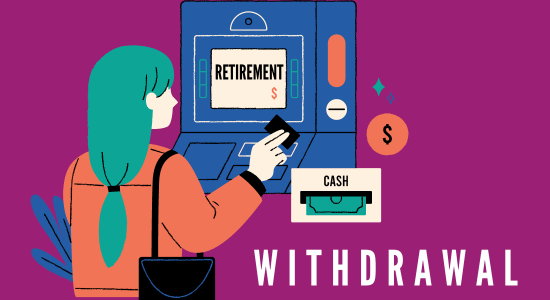Are you planning for retirement? Do you know what mistakes to avoid when it comes to securing your financial future? You may not think retirement planning is needed immediately, but just by knowing how you can avoid common mistakes, you can start making all the difference now.
So here are five of the most common pitfalls people face when planning for retirement and how to steer clear of them. Whether you're nearing retirement age or still have decades to go, these tips will help ensure that your golden years are truly golden!

1. Not Having a Proper Retirement Plan
Retirement planning is not something that should be taken lightly. Unfortunately, many people make the mistake of not having a plan in place at all. This can lead to financial instability and stress later on in life.
One common reason for not having a retirement plan is simply procrastination. It can be easy to put off thinking about retirement when it seems so far away, but time flies by faster than you think. Before you know it, you could find yourself nearing retirement age without any savings or plans in place.
Another reason some people neglect to create a retirement plan is because they believe they don't have enough money to save or invest. However, even small contributions over time can add up significantly and make a big difference down the road.
Not having a clear idea of what your goals are for retirement is another pitfall that many people fall into. Without direction, it's hard to work towards something concrete.
What Should You Do?
To start with, here are the factors you may want to take into account.
- Your retirement goals: Determine how much income you'll need in retirement and when you plan to retire. This will help you determine how much you need to save and how long you have to save it.
- Your current age: The earlier you start saving for retirement, the better, as it allows you to take advantage of compound interest. However, even if you're starting later in life, it's never too late to begin saving.
- Your risk tolerance: Consider how much risk you're willing to take on in your investments. Generally, the closer you are to retirement age, the less risk you should take on, as you have less time to recover from market downturns.
- Your employer's retirement plan: If your employer offers a retirement plan, such as a 401(k), be sure to take advantage of it. If your employer offers matching contributions, try to contribute enough to take full advantage of that benefit.
- Tax implications: Consider the tax implications of different retirement plans. Traditional retirement plans may allow you to deduct your contributions from your taxes, while Roth plans provide tax-free withdrawals in retirement.
- Fees and expenses: Consider the fees and expenses associated with different retirement plans, as they can eat into your returns over time.
- Diversification: Be sure to spread your investments across different asset classes, such as stocks, bonds, and real estate to reduce risk and maximize returns.
- Your overall financial situation: Consider your overall financial situation, including your debt, emergency fund, and other financial goals, when determining how much to save for retirement.
Take the time to sit down and determine what kind of lifestyle you want during your golden years and how much money you'll need to achieve that lifestyle.
Did You Know?
- Starting Too Late: Approximately 23% of Americans admit to not starting their retirement savings until their late 40s or beyond.
- Underestimating Expenses: Roughly 40% of retirees report that their post-retirement expenses were higher than they expected.
- Not Saving Enough: Data shows that 64% of Americans are likely to retire with less than $10,000 saved, which is significantly insufficient.
- Ignoring Health Care Costs: The average retired couple will need approximately $295,000 to cover health care expenses in retirement, not covered by Medicare.
- Failing to Adjust Investments: About 52% of retirees have not adjusted their investment portfolios in response to market changes during their retirement.
2. Not Contributing To a Retirement Account
One of the biggest mistakes people make when planning for retirement is not contributing to a retirement account. Many people assume they will be able to rely solely on their social security benefits or savings, without realizing that these may not be enough to sustain them throughout their golden years.
By failing to contribute regularly to a retirement account, you could miss out on valuable tax benefits and compound interest over time. Even if you start small with your contributions, try putting money into your retirement fund consistently if you can.
What Should You Do?
The type of retirement plan you should have depends on a variety of factors, including your age, income, retirement goals, and personal preferences. Here are some common retirement plans to consider:
- 401(k) plan: This is an employer-sponsored retirement plan that allows you to contribute pre-tax dollars to a retirement account. Your employer may also offer matching contributions, which can boost your savings.
- Traditional IRA: This is an individual retirement account that allows you to contribute pre-tax dollars to an investment account. You may be able to deduct your contributions from your taxes, and your investments grow tax-free until you withdraw them in retirement.
- Roth IRA: This is similar to a traditional IRA, but you contribute after-tax dollars and your investments grow tax-free. Withdrawals in retirement are also tax-free.
- Pension plan: This is a retirement plan that provides guaranteed income in retirement, typically based on your salary and years of service with an employer. These plans are less common than they used to be, but some employers still offer them.
- Annuities: An annuity is a financial product that provides regular income in retirement. They can be purchased from insurance companies or financial institutions.
Take your specific financial situation and goals into account when choosing a retirement plan. You may want to speak with a financial advisor to help you choose the best plan for your needs.
Remember, investing in your future through regular contributions now can pay off significantly later down the road. Don't let procrastination or uncertainty hold you back from securing a comfortable retirement for yourself.
3. Withdrawing From a Retirement Account Too Early

Withdrawing from your retirement account too early can have serious consequences on your future financial stability. Many people make the mistake of tapping into their retirement savings to cover unexpected expenses or even for a vacation, without realizing the impact it could have on their long-term plans.
Withdrawing money before you reach age 59 and a half will result in an additional IRS penalty, adding insult to injury. Additionally, taking out money now means forfeiting potential growth you would have seen had those funds remained invested.
Just remember why you started contributing to your retirement plan in the first place - so that one day you can enjoy a comfortable life after work. By dipping into those savings too early, you're robbing yourself of that future security.
What Should You Do?
Before considering withdrawing from your retirement account, explore other options to manage your financial situation. Here are some ideas:
- Review your budget: Take a look at your monthly expenses and identify areas where you can cut back. Consider canceling subscriptions or memberships you don't use, reducing your cable or phone plan, or finding ways to lower your utility bills.
- Find ways to increase your income: Consider taking on a part-time job or freelance work to earn extra income. You could also look for ways to monetize a hobby or talent.
- Delay retirement: If possible, consider delaying retirement to give yourself more time to save and reduce the amount you need to withdraw from your retirement account.
- Consider a loan: Depending on your retirement plan, you may be able to take out a loan from your account instead of withdrawing funds. However, this option should be used sparingly, as it can reduce the amount of money you have available for retirement.
- Seek professional advice: Consider speaking with a financial advisor to help you explore your options and determine the best course of action for your situation.
Remember, withdrawing from your retirement account prematurely can have long-term consequences, including taxes, penalties, and reduced retirement income. Consider all these options before taking money out of your retirement account. If all else fails, again, speak with a financial advisor who can help guide you toward alternative solutions instead of jeopardizing your retirement goals.
Did You Know?
- Overlooking Inflation: Only 38% of retirement plans account for inflation impacts, significantly reducing purchasing power over time.
- Relying Solely on Social Security: Social Security only replaces about 40% of an average worker’s pre-retirement income, yet 36% of retirees rely on it as their primary income source.
- Not Consulting Financial Advisors: Only 33% of people seek professional financial advice when planning for retirement.
- Withdrawing Too Early: 33% of people begin withdrawing from their retirement accounts before reaching the age of 59.5, incurring penalties and taxes.
- Underutilizing Tax-Advantaged Accounts: Only 32% of workers maximize their contributions to tax-advantaged retirement accounts like IRAs and 401(k)s.
4. Not Considering Inflation

One of the common mistakes people make when planning for retirement is not considering inflation. Inflation refers to the rise in prices of goods and services over time, meaning that your money may not be worth as much in the future as it is now.
For example, if you plan to retire in 20 years with a certain amount of savings that you expect will last throughout your retirement, you need to take into account how much prices are likely to increase during that time. If you don't consider inflation, your savings may run out sooner than expected.
Inflation can also affect investments such as bonds or stocks. Choose investments that have a history of keeping up with or even beating inflation rates. Otherwise, your investment returns could be eroded by inflation over time.
What Should You Do?
Invest in assets that are likely to keep pace with inflation - assets that have the potential to increase in value over time and provide returns that keep up with or exceed the rate of inflation. Here are some examples of assets that may keep pace with inflation:
Stocks:
Historically, stocks have provided returns that exceed the rate of inflation over the long term. You may be able to benefit from the growth potential of the stock market and help protect your purchasing power.
Real estate:
Real estate is another asset that may keep pace with inflation, as property values and rental income can increase over time. By investing in rental properties or real estate investment trusts (REITs), you may be able to benefit from the growth potential of the real estate market.
Inflation-protected bonds:
Inflation-protected bonds, also known as Treasury Inflation-Protected Securities (TIPS), are bonds issued by the US government that are designed to provide returns that keep pace with inflation. These bonds are indexed to the Consumer Price Index (CPI) and provide a fixed rate of return above inflation.
Commodities:
Commodities such as gold, silver, and oil can also provide returns that keep pace with inflation. However, investing in commodities can be risky and may not be suitable for all investors.
Note that no investment is completely risk-free, and past performance is not a guarantee of future results. Consider your investment goals, risk tolerance, and time horizon carefully.
Did You Know?
- Ignoring Long-term Care Needs: Statistics indicate that 70% of those over 65 will require some form of long-term care, yet only 14% have planned for these costs.
- Debt at Retirement: 43% of Americans aged 65 and older still carry debt into retirement, affecting their income and savings.
- No Written Plan: About 78% of Americans do not have a written retirement plan, which can lead to inadequate preparation and missed opportunities.
- Expecting to Work Part-time: While 55% of workers expect to work during retirement, only 18% actually do, often due to health issues or job availability.
5. Not diversifying your investment portfolio
Not diversifying means putting all of your money into one type of investment, such as stocks or real estate, rather than spreading it out among different types of assets.
The problem is that if the market takes a downturn in one area, you could potentially lose a significant amount of money. For example, if you have all your savings in tech stocks and there's a sudden crash in the industry, you will suffer greatly.
What Should You Do?
You want to reduce risks and protect your investments. The majority of us are struggling to make ends meet, we don't have a lot of money to invest.
With that said, there are several ways you can still achieve some level of diversification, even with a small amount of money. Here are some options to consider:
Invest in low-cost index funds:
Index funds are a type of mutual fund that seeks to match the performance of a particular market index, such as the S&P 500. By investing in a low-cost index fund, you can gain exposure to a portfolio of stocks or bonds with a relatively small investment.
Use robo-advisors:

Robo-advisors are digital investment platforms that use algorithms to create and manage a portfolio based on your investment goals and risk tolerance. Many robo-advisors have low minimum investment requirements and can help you manage your investments with a small amount of money.
Consider exchange-traded funds (ETFs):
ETFs are similar to mutual funds, but they trade like individual stocks on an exchange. By investing in an ETF that tracks a particular market index, you can gain exposure to a good portfolio with a relatively small investment.
Invest in target-date funds:
Target-date funds are a type of mutual fund that automatically adjusts its asset allocation based on your target retirement date. These funds typically hold a mix of stocks and bonds and can provide a simple solution for investors with a small amount of money.
Conclusion
Even if retirement seems far off, it's never too early to start planning for it. In fact, the earlier you start, the more time you have to save and invest, which can make a significant difference in your long-term financial security. Start to plan for retirement now, just do whatever you can do little by little, and you can take advantage of the power of compounding, which means that your money earns interest on interest over time. This can help your retirement savings grow significantly over the years.
Earn Some Money, Save For Retirement
You can earn money through affiliate marketing and use it to save for retirement. The amount you can earn will depend on various factors, such as your niche, the products or services you're promoting, the size of your audience, and how effectively you promote your content.
In general, the income potential for affiliate marketing can vary widely. Some affiliates may only earn a few hundred dollars per year, while others may earn thousands or even millions of dollars. Earning money through affiliate marketing takes time and effort, but if you're willing to learn, then there's no reason why you shouldn't start right here, right now. You'll build a loyal audience, create high-quality content, and promote your affiliate links to see results.
When it comes to saving for retirement, every little bit helps. Even if you're only earning a few hundred dollars per year through affiliate marketing, that money can add up over time and help you reach your retirement goals. The key is to be consistent and focus on long-term growth rather than short-term gains. By reinvesting your affiliate earnings into your business and retirement savings, you can build a sustainable source of income for the future.
How I "Finally" Make Over $7,000 Monthly Income
"The most valuable thing I've ever done!"
